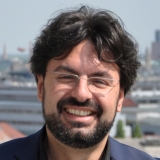
Center for Medical Physics and Biomedical Engineering
Position: Associate Professor
ORCID: 0000-0003-0279-6615
T +43 1 40400 39830
francesco.moscato@meduniwien.ac.at
Keywords
Artificial Intelligence; Artificial Organs; Biomedical Engineering; Cardiovascular System; Medical 3D-Printing; Models, Cardiovascular; Pattern Recognition, Automated; Signal Processing, Computer-Assisted
Research group(s)
- Ludwig Boltzmann Institute for Cardiovascular Research
Head: Johann Wojta
Research Area: The Ludwig-Boltzmann-Cluster for Cardiovascular Research focuses on interdisciplinary research of therapies for cardiovascular diseases.
Members: - Cardiovascular Dynamics and Artificial Organs
Head: Francesco Moscato
Research Area: The research group deals with investigation, development and simulation of cardiovascular devices and hemodynamics for diagnostic and therapeutic tools.
Members: - Additive Manufacturing for Medical Research
Head: Francesco Moscato
Research Area: The research group investigates physical and digital 3D modeling and engineering for improving medical implants and devices, surgical procedures and training.
Members:
Research interests
My research focuses on two main areas: medical 3d-printing and cardiovascular bioengineering. On the one hand, my research adresses the investigation of how 3d-printing could improve surgical and interventional procedures, medical device prototyping, tissue engineering and medical education. On the other hand, my efforts are devoted towards research and development of methods and devices to improve diagnostics and provide support to a range of cardiovascular pathologies.
Techniques, methods & infrastructure
Additive manufacruting (aka 3d-printing): technologies used Fused Filament Fabrication, Stereolithography, Multimaterial ink-Jetting, Metal Selective Laser Melting, Lithography-based Ceramic Manufacturing, 2-Photon-Polymerization, extrusion bio-printing. Mechanical and hemodynamic in-vitro and ex-vivo test setups, mathematical modeling including computational fluid dynamics, system identification and control, biosignal processing/machine learning using deep neural networks (e.g. CNN, RNN, BiLSTM, Transformers, GANs).
Grants
- In-silico 3D Cardiovascular Database - In-Silico-3DCD (2024)
Source of Funding: LBG (Ludwig Boltzmann Gesellschaft), Transformation Grant
Principal Investigator - New patient-specific surgical simulator - SIMIS (2023)
Source of Funding: aws (austria wirtschaftsservice), Prototypenförderung
Principal Investigator - Optimized Hydrodynamic Flow Behavior by Selective Surface Functionalization of Ceramic 3D Printed Rotodynamic Blood Pumps - OPTIFLOW-3D (2022)
Source of Funding: FFG (Austrian Research Promotion Agency), Produktion der Zukunft
Coordinator of the collaborative project - TEXtile integrated HYbrid Printed Electronics - TEX-hype (2021)
Source of Funding: FFG (Austrian Research Promotion Agency), Produktion der Zukunft
Coordinator of the collaborative project - Ink-based hybrid multimaterial fabrication of next generation implants - INKplant (2020)
Source of Funding: EU, INDUSTRIAL LEADERSHIP - Leadership in enabling and industrial technologies – Nanotechnologies
Coordinator of the collaborative project - A neuroprosthesis to restore the vagal-cardiac closed-loop connection after heart transplantation - NeuHeart (2018)
Source of Funding: EU, EXCELLENT SCIENCE - Future and Emerging Technologies (FET)
Coordinator of the collaborative project - Additive Manufacturing for M3dical RESearch - M3dRES (2017)
Source of Funding: FFG (Austrian Research Promotion Agency), F&E-Infrastrukturförderung
Principal Investigator - Continuous Out-of-hospital Monitoring of Rotary Blood Pump Patients - RBP Monitoring (2014)
Source of Funding: FWF (Austrian Science Fund), Programme Clinical Research (KLIF)
Principal Investigator
Selected publications
- Civilla, L. et al. (2024) ‘Development and assessment of case-specific physical and augmented reality simulators for intracranial aneurysm clipping’, 3D Printing in Medicine, 10(1). Available at: https://doi.org/10.1186/s41205-024-00235-w.
- Haberbusch, M. et al. (2024) ‘Decoding cardiac reinnervation from cardiac autonomic markers: A mathematical model approach’, The Journal of Heart and Lung Transplantation, 43(6), pp. 985–995. Available at: https://doi.org/10.1016/j.healun.2024.01.018.
- Vostatek, M. et al. (2024) ‘Bone‐Mimetic Osteon Microtopographies on Poly‐ε‐Caprolactone Enhance the Osteogenic Potential of Human Mesenchymal Stem Cells’, Macromolecular Bioscience [Preprint]. Available at: https://doi.org/10.1002/mabi.202400311.
- Moscato, F. et al. (2021) ‘The left ventricular assist device as a patient monitoring system’, Annals of Cardiothoracic Surgery, 10(2), pp. 221–232. Available at: https://doi.org/10.21037/acs-2020-cfmcs-218.
- Moscato, F. et al. (2013) ‘Use of continuous flow ventricular assist devices in patients with heart failure and a normal ejection fraction: A computer-simulation study’, The Journal of Thoracic and Cardiovascular Surgery, 145(5), pp. 1352–1358. Available at: https://doi.org/10.1016/j.jtcvs.2012.06.057.